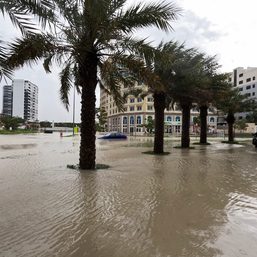SUMMARY
This is AI generated summarization, which may have errors. For context, always refer to the full article.

MANILA, Philippines – The Philippine government is working towards the repatriation of the three overseas Filipino workers (OFWs) who were confirmed dead following the massive flooding in the United Arab Emirates earlier this week, the Department of Migrant Workers (DMW) said late Friday, April 19.
The Migrant Workers Office (MWO) in Dubai and Overseas Workers Welfare Administration (OWWA) met with the three OFWs’ next of kin and explained the procedures for repatriation.
A strong storm first hit Oman over the weekend, killing at least 20 people, before pounding the UAE on Tuesday, April 16, with its heaviest rains in 75 years.
The DMW earlier confirmed the deaths of at least three OFWs, one 47-year-old Filipino male who died in a vehicular accident, and two women who died while their vehicle was submerged in floodwaters. The three reportedly died on Wednesday, April 17.
In a new update, the DMW said two other OFWs suffered injuries when they fell into a sinkhole. They are recuperating in the hospital.
The DMW and OWWA, together with the Philippine consulate in Dubai, are also assisting Filipinos whose flights were affected by the storm through food packs, essential personal items, and airline flight assistance. Airlines with delayed or rescheduled flights include Philippine Airlines, Cebu Pacific, and Emirates.
The MWO in Abu Dhabi has also distributed food and relief packs to some 800 OFWs living and working in the Al Touba district in Al Ain, one of the remote areas badly ravaged by the storm.
Returning to normal after a disaster
While the weather is improving, many areas in the UAE remain flooded. In an experience he shared to the overseas-filipinos chat room on the Rappler Communities app, John Elton Jornales, an OFW in Dubai, said on early Saturday, April 20, that he and other work companions were already back to work.
“We’re fine and baha pa rin ‘yung karamihan sa area namin pero onti-onti nang nagsa-subside ‘yung tubig. Good thing din second floor ‘yung flat namin. Pinasok ng tubig onti noong Tuesday kasi umapaw at stuck yung tubig sa balcony,” he said.
(We’re fine, and many areas in our area that are still flooded, but the water is slowly subsiding. Good thing our flat is on the second floor. A little water got inside on Tuesday because it got stuck and overflowed on the balcony.)
Jornales recalled an eventful April 16. From the beginning of their day at 8:15 am, they were on the way to work with no advice from the office about the weather. But during the commute, the rain heavily poured down with zero visibility.
In the Al Quoz area, they were stuck in traffic for over four hours as floodwaters began to rise. “Buti nakasuong ‘yung bus namin dahan-dahan, pero nakakatakot din kapag mastuck sa gitna ng tubig (Good thing our bus was able to move forward slowly, but it’s scary if you get stuck in the middle of the water).”
Upon reaching the office at 1 pm, Jornales said they only stayed for less than an hour before receiving an update from management that they could go home using the company’s transport service.
Around 3 pm, still on the road, heavy rains began pouring again. “Need namin magpatuloy kahit wala nang makita sa highway, and rinig na rinig na may onting, maliliit na yelo/hail storms na tumatama sa bintana namin na may kasamang sobrang lakas na hangin,” he said.
(We needed to forge on even if we couldn’t see anything on the highway anymore, and we could clearly hear ice/hail storms that were hitting our window along with the sound of strong gusts of wind.)
“Nakakatakot na kasi ‘yung iba walang baon na pagkain or tubig, kahit payong wala kasi ‘di namin ine-expect ‘yung nangyari. May matatanda na ayaw din maglakad kasi takot din,” he added.
(It was scary because others didn’t have packed food or water, not even an umbrella, because we didn’t expect what happened. There were also some elderly people who did not want to walk because they were also afraid.)


After four hours in traffic, Jornales, together with some other Filipinos and Indians, made the decision to wade through the mostly-flooded International City complex to make their way home.
“Naglalakad kami may baha, malakas na ulan at hangin na may kasamang kidlat at kulog. ‘Di na namin ininda lahat ‘yun at nagpatuloy umuwi ng bahay,” he said. (We walked through floods, heavy winds and rains accompanied by lightning and thunder. We endured all of it, and we continued until we got home.)
It was a 30-minute unprotected journey, but the workers were able to make it home safely.
Rains are uncommon in the UAE, known for a hot desert climate and temperatures that can soar above 50°C in the summer. – with reports from Reuters/Rappler.com
Add a comment
How does this make you feel?

![[EDITORIAL] Anyare, Pilipinas? Anyare, COP?](https://www.rappler.com/tachyon/2023/11/animated-marcos-duterte-cop28-carousel.jpg?resize=257%2C257&crop_strategy=attention)







There are no comments yet. Add your comment to start the conversation.